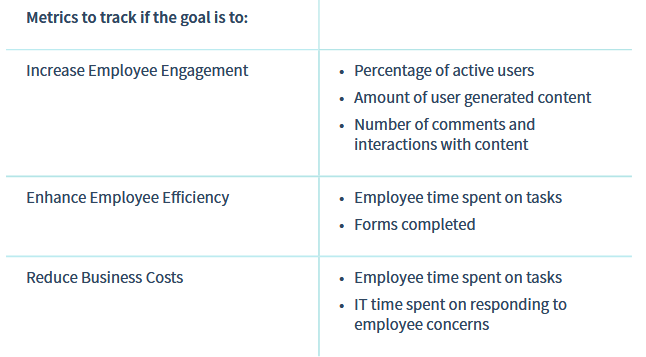6 Tactics to Modernize Your Intranet
What Defines a Modern Intranet?
Although the intranet is one of the most common solutions in an organization’s technology stack, it has become the cause of many workplace problems. The downfall of intranets can be attributed to many different factors, including a lack of governance and clear roles, strategic organizational misalignment, and poor implementation, among others.
However, intranets are still very critical to employee success, and therefore vital to the business. But for organizations to reap these benefits, they must first modernize their intranet solutions.
An employee-centric lens is what distinguishes a modern intranet from a traditional, outdated one. Without this focus, even the most technologically advanced intranet will not be used, since employees simply won’t find it helpful for their day-to-day tasks.
A modern intranet can bring benefits such as:

In order to gain these benefits, leaders should follow these best practices for the modernization of their intranets.
Tactics to Modernize Your Intranet
Before ripping apart your current intranet solution or scouting for new technologies to revamp the tool, remember that the success of an intranetrests on more than just the technology behind it.
Here are six best practices that we recommend adopting for a powerful modern intranet.
1. Focus on Your Internal Customers
In order to deliver better customer experiences, organizations must turn their attention first to their own internal customers: employees. Successful organizations understand that a correlation exists between customer experience (CX) and employee experience (EX). For a business to deliver exceptional customer experiences, the same investments and dedication need to be made into employee experiences.
We used to prioritize our stakeholders as shareholders first, customers second, and employees third. We now realize we had it backward. If we put employees first, they in turn take care of our customers, and they in turn take care of our shareholders. The Employee Experience: Culture, Engagement, and Beyond
Regardless of what stage an intranet is in, the organization must focus their attention on how to improve EX, and give their workforce the same quality of support and experience that they provide to customers.

Assess Workplace Needs
Tailor the intranet to the needs and preferences of the workforce. Determine the features needed to meet their needs by asking questions such as:
-
What does success look like to you?
-
What does a typical workday look like?
-
What roadblocks are currently in place? What are the biggest frustrations in your daily work experience?
-
What other tools are you currently using? How do you prefer to conduct your work?
-
What do you want from your intranet tool?
The answers to these questions will provide a clearer picture of what the intranet needs to accomplish.
2. Define the Purpose of the Intranet
For an organization that has not set any intranet goals yet, establish an overall intranet strategy.
Build Out Your Team
In order to do so, organizations must define requirements and governance with a group of stakeholders from IT, HR, Legal, and other relevant teams. This cross-functional team should come together to spearhead and guide the initiative for a tool that will support unique employee goals and requirements.

Having a cross-departmental intranet management team helps to:
-
Ensure that the intranet will continue to be maintained won’t be outdated and that it will be tailored and updated for employee needs and goals
-
Establish clear roles and responsibilities for decision-making
-
Bring together different voices from different teams to be heard
Once this team is assembled, they will be able to determine the purpose and specific goals for the intranet and begin the implementation process.
Track Metrics to Measure Success
Once the mission and goals are set, determine tangible KPIs that tie into existing business KPIs related to employee engagement and the bottom line of the business. This will help reinforce the value a modern intranet can bring to both the vitality of individual employees and the organization.
Depending on the goal and mission, relevant metrics will vary but here are a few common ones to track:

While tracking metrics and determining what data to collect might be difficult, defining these performance indicators will make it possible to calculate ROI, to measure success, and to find areas for improvement.
Create a Feedback Loop
Like most systems, modern intranets are not a “set it and forget it” technology. In addition to providing a feedback center where employees can easily submit ideas and suggestions for their intranet, the team should meet regularly to assess key performance metrics and evaluate intranet effectiveness and relevancy.
Consider asking consistent questions at every meeting to measure progress, such as:
-
Is the intranet meeting the goals that were originally set?
-
Is the technology investment returning value?
-
Among employee feedback, are there identifiable patterns for changes or requests?
-
Are there changes, either in the organization or even general employee trends that would affect the purpose or goal of the intranet?
As the nature of work and employee experience continue to change, teams should prepare to regularly make updates that improve upon their intranet’s functionality.
3. Enable Deskless and Remote Workers
By the end of 2021, researchers estimate that 25-30% of the workforce will be working from home, or other locations, multiple days a week.3
Given this shift towards remote work, employers must consider how to enable their team members who might not work from an office space. This doesn’t mean trying to replicate the face-to-face experience but rather, optimizing the remote experience.
Is the intranet able to handle the influx of remote workers and does it provide the capabilities to help these workers stay productive and connected?
Deskless, but Not Faceless
Give remote and deskless workers an easy way to connect, collaborate, and contribute to the organization, whether they’re in the field or at homewith mobile intranet functionalities.

Increase Collaboration and Engagement
According to The State of Remote Work 2020, one of the biggest challenges remote and out-of-office workers struggle with is communication and the lack of connection.5 Intranets ensure that employees, regardless of where they are working from, can collaborate with any team member. Teams are informed of critical news and updates, and are equipped to provide consistent levels of service globally.
4. Choose the Right Technology
Leaders must consider which technology will help serve their organizational needs, such as meeting timeline, budget, and ease of use.
Evaluate modern intranets by asking if the technology is:
-
Scalable? Is it able to handle the complexities of the organization, especially as the company continues to expand and globalize?
-
Secure? Will the intranet be safe to access, especially for those not working from the office?
-
Easy to manage and maintain? Will it take up significant resources and time for teams?
-
Easy for employees to learn how to use? Is the user interface intuitive?
-
Able to integrate with other applications and systems easily? How powerful are the integration capabilities?
-
Able to facilitate two-way communications?
Is the intranet capable of enabling communication from employees to employers as well?
To get a better idea of what the top intranet vendors’ capabilities are and how they stack up, dive into this report published by Forrester. Grab the Forrester Wave Report for Intranet Platforms
5. Increase Employee Efficiency
Make the intranet an all-in-one hub for employees to find the information they need. Cut through the noise and surface the most important information for each employee.

In addition to hosting relevant information in knowledge bases and wikis that are easily accessible, make it easy to find content with dynamic tagging and enhanced search capabilities.
Consolidate Employee Tools
To increase employee productivity and reduce context switching, businesses can utilize their modern intranet as the singular hub for employees to collaborate with other teams, receive company updates and notifications, and perform their tasks.

Integration will be key here. The intranet will need to be able to easily connect with third-party applications, existing systems and databases, and any future tools that may become necessary.
6. Onboard and Train for Increased Adoption
The success of an intranet tool will wholly depend on the adoption from employees. If employees don’t understand the purpose and the benefits of their intranet, then why would they use it?
For new employees, include intranet training into the onboarding process. If not onboarded properly, new hires will be less productive, which can increase the turnover rate. Help these new team members understand the tools and processes that will help them succeed.
Make Sure Training Never Stops
Host training sessions to continue demonstrating how to use the business’ modern intranet; go over sample use cases and demos of how specific employees could leverage the tool. Additionally provide a knowledge base that hosts articles, tutorials, and commonly asked questions to allow employees to reference and review on their own.
Conclusion
Let’s imagine this scenario: your business is thriving and running efficiently. You can attribute this success back to employees that are productive, engaged, and enabled to do their work through a modern intranet. Don’t let this scenario be fictional; an intranet can be a very powerful tool to serve and grow your employees. Leverage these best practices to start utilizing the full potential of your workforce.
Moving Forward
Use a powerful digital experience platform to build a modern intranet to support the entire workforce. See how Liferay DXP helps organizations solve their workplace challenges.
Get Features List here


Darren Sepanek
Experienced global marketing professional with a demonstrated history of working in the computer software industry. Expertise in communications, integrated lead generation campaigns, brand development, management, business development, and marketing operations.